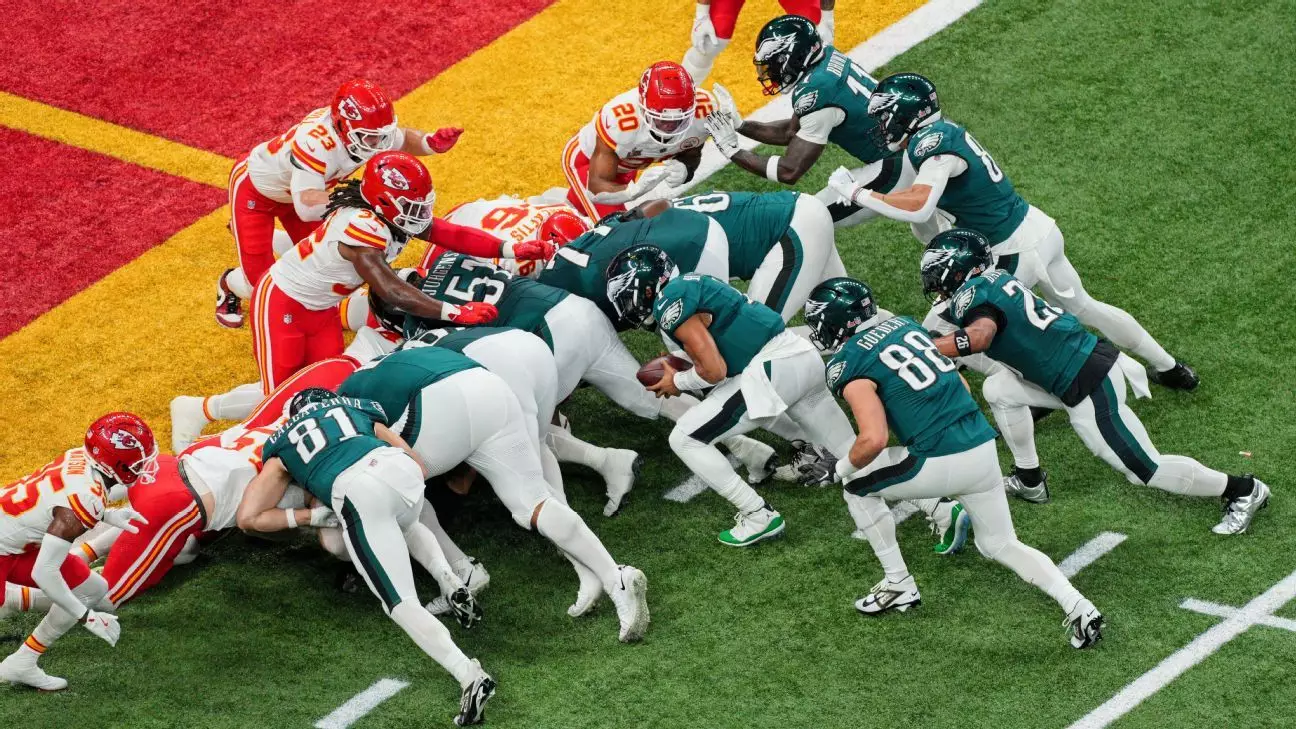The National Football League (NFL) continuously evolves its rules to ensure fair play and enhance the viewing experience. One of the most debated plays currently is the so-called “tush push,” a quarterback sneak strategy that some teams execute with remarkable success. At the recent scouting combine, Troy Vincent, the NFL’s executive vice president of football operations, revealed that a proposal has been submitted to ban this play. While Vincent did not disclose which team initiated the proposal, the implications of this move deserve in-depth analysis.
The “tush push” refers to a specific quarterback sneak where additional players align behind the quarterback to provide extra momentum. This tactic has garnered significant attention, particularly due to its successful application by teams like the Philadelphia Eagles and the Buffalo Bills. Recent statistics indicate that these teams executed the play with a remarkable 87% success rate in achieving first downs or touchdowns, far exceeding the league-wide average of 71%. Such dominance has sparked concern and envy among rival teams, leading to the current proposal aimed at abolishing the tactic.
The efficiency of the “tush push” is not merely a footnote in NFL strategy; it represents an evolution in offensive play-calling that emphasizes physicality and teamwork. Jalen Hurts, the Eagles’ quarterback, famously showcased the “Brotherly Shove” in Super Bowl LVII, cementing its place in football lore. However, elements of the play have raised eyebrows and drawn scrutiny from within the league, prompting calls to reevaluate its legitimacy.
According to Vincent, the proposal’s status will be determined next month during the NFL spring meeting in Palm Beach, Florida. To pass, a significant majority—at least 24 of the 32 team owners—must approve the ban. This voting mechanism highlights the democracy inherent in the league’s operations, although it also reflects deeper tensions among franchises. Some teams feel at a competitive disadvantage when facing rivals that utilize the “tush push” effectively, creating a rift between those favoring traditional play styles and those advocating for innovation.
The fact that this proposal is on the agenda indicates that the league officials have recognized the “tush push” as a point of contention, considering both its offensive success and the potential for injuries stemming from the play’s physical nature. The historical context of tactics like this often reveals evolving sentiments within the league: just three years earlier, conversations surrounding “hip-drop” tackles created similar debates regarding player safety and unsportsmanlike conduct.
Supporters of the “tush push,” including Eagles head coach Nick Sirianni, argue that the play’s effectiveness should not warrant a rule change. Sirianni maintains that the success of the play is not mirrored across the league, implying that it is not merely about the tactic itself but how effectively a specific team executes it. His perspective reflects a wider belief that competitive advantage should stem from skill and preparation rather than legislative intervention by the league.
Contrarily, those in favor of banning the play cite concerns over player safety, particularly regarding the violent collisions that ensue during such maneuvers. Defensive players, like Washington Commanders linebacker Frankie Luvu, have faced severe penalties when attempting to counteract the play, illustrating the inherent risks associated with a tactic that involves multiple players heaving against a defensive line.
As teams prepare for potential changes in rules, the future of the “tush push” remains a hot topic of discussion. If the proposal gains enough support and ultimately passes, it could reshape offensive strategies across the league. Coaches may be compelled to develop alternative tactics in crucial short-yardage situations, adding an additional layer of complexity to game-planning.
The NFL’s decision-making processes must accommodate both innovation in gameplay and the preservation of fairness and player safety. As debates ensue about the merits and drawbacks of banning specific plays, it is clear that the heart of the dispute lies in a fundamental question: should excellence dictate the rules of the game, or should all teams operate under the same set of guidelines regardless of capability? The answers remain uncertain, but they will undoubtedly influence the evolution of football as fans know it today.

